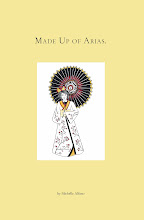 Our Town: A Play in Three Acts by Thornton Wilder (1938; republished by Longman, Green & Co. , 1956) 129 pp.
Our Town: A Play in Three Acts by Thornton Wilder (1938; republished by Longman, Green & Co. , 1956) 129 pp.I picked up an old volume of this play at the Victoria College Book Sale, an annual event that I have come to enjoy since having started working at the university. The university has four annual sales at four different colleges: Victoria, University, Trinity and St. Michael's Colleges - Trinity being the best I think.
I love this volume published in 1956: faded green cloth hard bound covers and yellowed, slightly brittle pages with that old book smell.
The audience is directly addressed by the "Stage Manager" who serves almost as a Greek chorus to the events that take place effectively smashing the fourth wall. The stage is minimal, the scenery almost non-existent - one must imagine all that is described to you. The Stage Manager is akin to a "homespun philosopher" or perhaps one of Shakespeare's fools - commenting on the plot's development.
The sets are exceedingly simple: two ladders represent George and Emily in their respective rooms doing homework, a row of chairs representing the church sequence, etc ...
In Act Two, the two young people fall in love and marry. The scenes are honestly portrayed. The parents have misgivings as do the bride and groom who have cold feet at the altar. Emily wears only a veil as a symbol of the wedding ceremony. There are frequent flashbacks which provide a back story for the characters' growing attachment prior to their engagement.
George's mother is there as is Simon Stimson, the town drunkard, and Mrs. Soames, a lady who attended Emily and George's funeral. Emily soon joins this group, somewhat dazed, as if she has not quite navigated the trip from the living to the dead. She watches her husband and family at the ceremony and begs to return for one more day.
The dead discourage her by telling her that she will regret it because she will always carry the knowledge of her death with her into the past life. Despite their warnings, Emily insists and returns for a day - for a specific moment - the morning of her 12th birthday, a day of great joy for her. But it is too painful. It is painful for the reader as well as.
Emily retreats to the world of the dead, consoled by the others and now accepting her new existence. It is an intriguing mix of realsitic drama with the fantastic and an utter surprise for me, a novice to this genre.









No comments:
Post a Comment